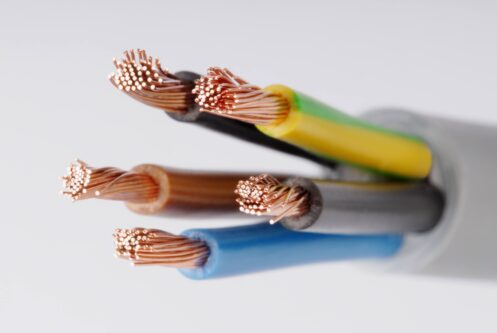Over the years, electrical wiring has undergone a lot of changes. While modern homes mostly use flexible wires covered in a protective coating, older homes may use entirely different systems. Knob-and-tube wiring is a somewhat outdated wiring method that still exists in certain buildings. This historic wiring method can lead to some problems, so it’s important to know if your property has it.
What Is Knob-and-Tube Wiring?
Knob-and-tube wiring was a popular method for adding electricity to homes in the Victorian era. This type of wiring gets its name from the ceramic or porcelain knobs used to mount the system. To install knob-and-tube wiring, electricians would attach wires to knobs and then run them through hollow tubes mounted into a home’s walls. Even then, the wires were copper like modern wires, but they tended to be much thicker. Instead of having plastic to insulate them, the wires were insulated by the knobs, the tubes, and a cloth or rubber coating.
Ways to Identify Knob-and-Tube Wiring
Not sure if your home has knob-and-tube wiring? There are a few things you can do to check.
Research the Age of Your House
If you suspect that you have knob-and-tube wiring, the first thing you should do is find out the age of your house. Historically, knob-and-tube wiring was most frequently used between 1880 and 1940. If your house was built within this time period, knob-and-tube is a definite possibility. There’s also a chance you might have it if your home was built earlier but had electricity installed during this time period. Though rare, some homes from the 1950s or 1960s might have also had knob-and-tube installed by an electrician who preferred older methods.
Look in Your Basement or Attic
Since it goes through the walls of your home, this type of wiring isn’t immediately visible. However, it was quite common for electricians to run it under floors or over ceilings. If you have a basement or attic, try visiting it and looking closely at the joists. If you see any white knobs nailed to joists and wrapped in wires, you probably have knob-and-tube wiring. You can also check for hollow pipes that run through joists and contain electrical wires.
Read Your Home Inspection Report
If you recently bought the property, you can find out more about your electrical system by going over the inspection report. Most professional home inspectors can spot knob-and-tube wiring easily. They will usually make a mention of your house’s wiring type in the section of the report that focuses on the electrical system.
Examine Your Fuse Panel
Visit the electrical panel in your house to get a better idea of what type of wiring you have. Modern electrical wiring systems will have a breaker box that contains several switches to flip the power on and off. Meanwhile, knob-and-tube systems tend to use an older fuse system where the box has a small, round, glass fuse for each circuit. Furthermore, older systems will often have far fewer circuits. While modern wiring might have around 15 to 20 breakers, knob-and-tube wiring might just have four to six circuits. If your home has been partially retrofitted at some point, it’s possible to have knob-and-tube on a breaker box or modern wiring on an old fuse box. However, if you see a fuse box, it’s much more likely that your home has knob-and-tube wiring.
Check Your Electrical Fixtures
Knob-and-tube wiring has a few quirks that can become noticeable when you start installing modern electrical fixtures in your house. The big one is that knob-and-tube wiring doesn’t have a ground wire. It only has a hot wire and a neutral wire. This means that if you try to install a modern light or ceiling fan, you’ll notice there are only two wires to work within instead of a third one to provide grounding or a fourth one to connect to a switch. Another check you can do through your electrical fixtures is a test of the amperage. Many knob-and-tube systems have a higher amperage than modern systems, and you can identify this by using a multimeter on your home’s wiring system.
Look Inside the Walls
If all other detection methods fail, it might be time to look inside your walls. Getting a look at the interior of your home’s walls will tell you exactly what type of wiring you have. Of course, doing this can be tricky if you don’t want to break a huge hole into one of them. A less invasive option is to get your wiring inspected by camera. An electrician can pass a small camera through a tiny hole or gap in your wall to see what type of wiring you have.
Ask for Help From a Professional
Some homeowners get lucky and can spot knob-and-tube wiring sticking straight out of their basement ceiling. However, identifying your type of electrical system isn’t always that simple. Not only are some types of wiring hidden in hard-to-reach spots, but some houses can also have a confusing mix of new and old wiring techniques. If you have any doubt about whether or not you have knob-and-tube wiring, go ahead and schedule an inspection from an electrician who works on older homes. They can examine your wiring more closely and definitively tell you whether or not your home still has knob-and-tube wiring.
What Should You Do About Knob-and-Tube Wiring?
If you have knob-and-tube wiring, the next question is if you should be concerned. Though the idea of outdated wiring can sound scary, the reality is that this wiring system is very durable. The porcelain used to mount the wiring can last for hundreds of years. Therefore, there is a lot of antique knob-and-tube wiring that works just fine. It even has some advantages like the fact that it’s held away from the walls and is less likely to be punctured during DIY shelving installations.
However, this type of wiring can experience some damage. It can stretch as buildings settle over time, and past home construction can crack the porcelain. Some types of insulation, like fabric or fiber, can also deteriorate and cause fire hazards. Therefore, it’s essential to get your knob-and-tube wiring inspected by professionals. They can let you know whether it’s still working well or if it needs to be replaced. Even if your knob-and-tube wiring is still working well, you might want to replace it anyway. Some insurance companies won’t cover it, and it’s so outdated that many modern electricians don’t know how to work on it.
At Thermo Direct, we have plenty of experience working with this unusual type of electrical system. We’re happy to inspect your system and let you know whether it’s in good shape. In addition to helping with electrical work in older homes, our team also provides a variety of other home services throughout the Raleigh area. We can help you with repairing and installing a variety of heating, cooling, electrical, and plumbing systems. Contact us at Thermo Direct today to find out more.









